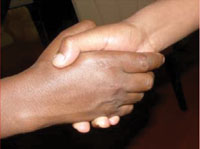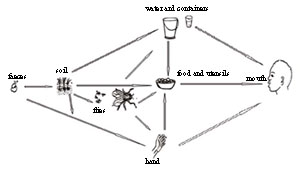As we mentioned in the Introduction to this study session, faeco-oral transmission means 'from faeces to mouth'. But the route can either be direct transmission from contaminated hands touching the mouth and transferring the infectious agents directly; or indirect transmission through consumption of food or water, or using utensils, contaminated with the infectious agents.
How could a person's hands become contaminated with faeces?
Show answer
You may have thought of several ways, including:
- Using the toilet and not washing the hands afterwards
- Cleaning a child's bottom after defaecation
- Shaking hands with someone whose hand is already contaminated (Figure 32.1)

Figure 32.1 Contaminated hands can easily transmit infectious agents directly to the mouth. (Photo: Basiro Davey)
- When flies rest on the hand after they have crawled on faeces
- Accidentally touching faeces in the soil where people or animals have defaecated in the open fields.
Faeces can also contaminate food or water, indirectly transmitting the infectious agents when a person eats the food, or drinks the water, or some gets into the mouth during washing. Diseases transmitted indirectly by food or water are called foodborne diseases and waterborne diseases respectively (see Box 2.2 in Study Session 2).
Can you suggest some ways that food could become contaminated with faeces?
Show answer
You may have thought of several ways, including:
- Contaminated hands touching food during preparation or eating
- Using contaminated water to prepare food (e.g. washing fruit)
- Using contaminated utensils (knife, spoon, bowl, etc.) to prepare or eat food
- Feeding a baby with contaminated milk, or using a contaminated bottle
- Flies resting on food after crawling over faeces
- Serving inadequately cooked fruit and vegetables grown in soil contaminated with faeces.
How could water become contaminated with faeces?
Show answer
You may have thought of several ways, including:
- Sources of water (streams, wells, etc.) can be contaminated with faeces washed out of the soil by heavy rain if people defaecate in open fields, or in poorly constructed latrines
- Hands or utensils for eating or drinking may be washed in contaminated water
- Contaminated containers may be used to fetch or store water.
The correct construction of latrines is taught in the Hygiene and Environmental Health Module.
The examples given above illustrate faeco-oral transmission via the six Fs: food, fingers, flies, fluids, faeces and fomites. Figure 32.2 illustrates the different ways that faeco-oral transmission can occur.
Fomites ('foh-mytz') is the term given to non-living things (e.g. bowls, water containers, soil) that can transmit infection indirectly.

Figure 32.2 Different ways that faeco-oral transmission of infectious agents can occur. (Source: adapted from AMREF, 2007, Communicable Diseases Distance Education Program, Unit 11)

